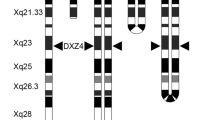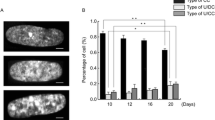Summary
The eu- and heterochromatic behavior of the late replicating X chromosome in the cell cycle was investigated with a double labeling method by means of H3- and C14-thymidine. It was ascertained that the X chromosome decondenses in retardation after mitosis and appears for a short time as sex chromatin. In cells with a sufficiently long cell cycle, a heterochromatization can occur again during interphase. In cells with a short cell cycle the X chromosome condenses only precociously before mitosis and becomes heterochromatic. Whereas the formation of the mitotic sex chromatin depends on the cell cycle, the interphasic sex chromatin is widely independent of the cell cycle. Examination of living fibroblasts with phase contrast microscopy confirms the results obtained by the double labeling method.
It is concluded from the autoradiographic replication pattern, the condensational behavior in prophase, and sex chromatin findings among X fragments, that the short arm of the X chromosome is euchromatic during interphase and that the interphasic sex chromatin is formed only by the long arm of the X chromosome.
It follows from the findings, which argue for and against the X inactivation, that the Lyon hypothesis (1962) should be modified by the following points: 1. The X chromosome is genetically active in the euchromatic condition. 2. The activity is of a regulative kind. 3. The differentiation into the early- and late-replicating X chromosome takes place not during embryogenesis, but already during the first cell division of the zygote. 4. The supplementary hypothesis of Lyon (1962) that single structural genes are on the X chromosomes or that structural gene activity occurs before “inactivation” cannot be correct.
Zusammenfassung
Mit einer Doppelmarkierungsmethode von H3- und C14-Thymidin wurde das eu- und heterochromatische Verhalten des spätreplizierenden X-Chromosoms im Zellcyclus untersucht. Es wurde festgestellt, daß das X-Chromosom nach der Mitose verzögert dekondensiert und für kurze Zeit als Geschlechtschromatin erscheint. In Zellen mit genügend langem Zellcyclus kann dann während der Interphase wieder eine Heterochromatisation erfolgen. In Zellen mit kurzem Zellcyclus kondensiert das X-Chromosom erst vor der Mitose vorzeitig und wird heterochromatisch. Während die Bildung des mitotischen Geschlechtschromatins vom Zellcyclus abhängt, ist die Entstehung des interphasischen Geschlechtschromatins vom Zellcyclus weitgehend unabhängig. Phasenkontrastuntersuchungen an lebenden Fibroblasten bestätigen im wesentlichen die Ergebnisse mit der Doppelmarkierungs-methode.
Aus dem autoradiographischen Repliktionsmuster, der chromosomalen Kondensation während der Prophase und Geschlechtschromatinbefunden bei X-Fragmenten wird geschlossen, daß der kurze Arm des X-Chromosoms während der Interphase euchromatisch ist und das interphasische Geschlechtschromatin nur vom langen Arm des X-chromosoms gebildet wird.
Aus den Befunden, welche für und gegen die X-Inaktivierung sprechen, ergibt sich, daß die Lyon-Hypothese (1962) in den folgenden Punkten modifiziert werden muß: 1. Das X-Chromosom ist im euchromatischen Zustand genetisch aktiv. 2. Die Aktivität ist regulativer Art. 3. Die Differenzierung in früh- und spätreplizierendes X-Chromosom tritt nicht erst während der Embryogenese ein, sondern schon während der ersten Zellteilung der Zygote. 4. Die Zusatzhypothesen von Lyon (1962), daß sich einzelne strukturelle Gene auf dem X-Chromosom befinden oder eine strukturelle Genaktivität vor der “Inaktivierung” besteht, können nicht stimmen.
Similar content being viewed by others
References
Abercrombie, M.: Contact inhibition: The phenomenon and its biological implication. J. nat. Cancer Inst. Monogr. 26, 249–277 (1967)
Atkins, L., Santesson, B., Voss, H.: Partial deletion of an X chromosome. Ann. hum. Genet. 29, 89–95 (1965)
Back, F., Dörmer, P.: X-chromosome activity in lymphocytes. Lancet 1967 I, 385
Barr, M. L., Bertram, E. G.: A morphological distinction between neurones of the male and female, and the behaviour of the nuclear satellite during accelerated nucleoprotein synthesis. Nature (Lond.) 163, 676–677 (1949)
Baughman, F. A., Kolk, K. v. d., Mann, J. D., Valdmanis, A.: Two cases of primary amenorrhea with deletion of the long arm of the X chromosome (46 XXq-). Amer. J. Obstet. Gynec. 102, 1065–1069 (1965)
Becker, K. L., Paris, J., Albert, A.: Ovarian dysgenesis due to deletion of the X chromosome. Proc. Mayo Clin. 38, 389–394 (1963)
Bianchi, N., Lima-de-Faria, A., Jaworska, H.: A technique for removing silver grains and gelatin from tritium autoradiographs of human chromosomes. Hereditas (Lund) 51, 207–211 (1964)
Comings, D. E.: Sex chromatin, nuclear size and the cell cycle. Cytogenetics 6, 120–144 (1967)
Court Brown, W. M., Harnden, D. C., Jacobs, P. A., Maclean, N., Mantle, D. J.: Abnormalities of the sex chromosome complement in man. Med. Res. Counc. Rep. No. 305 (London) (1964)
de Grouchy, J., Lamy, M., Yaneva, H., Salomon, Y., Netter, A.: Further abnormalities of the X-chromosome in primary amenorrhea or in severe oligomenorrhea. Lancet 1961 II, 777–778
De la Chapelle, A.: Cytogenetical and clinical observations in female gonadal dysgenesis. Acta endocr. (Kbh.) 40, Suppl. 65, 1–122 (1962)
DeMars, R.: Sex chromatin formation during interphase of human fibroblasts. Science 146, 424 (1964)
Engel, E., Forbes, A. P.: Cytogenetic and clinical findings in 48 patients with congenitally defective or absent ovaries. Medicine (Baltimore) 44, 135–164 (1965)
Ferguson-Smith, M. A., Alexander, D. S., Bowen, P., Goodman, R. M., Kaufmann, B. H., Jones, H. W., Heller, R. H.: Clinical and cytogenetical studies in female gonadal dysgenesis and their bearing on the cause of Turner's syndrome. Cytogenetics 3, 255–363 (1964)
Fraccaro, M., Hanson, K., Lindsten, J., Tiepolo, L.: Heterochromatin in pre-implantation mouse embryos. Exp. Cell Res. 55, 427–430 (1969)
Fraccaro, M., Lindsten, J., Mittwoch, U., Zonta, L.: Size of drumsticks in patients with abnormalities of the X-chromosome. Lancet 1964 II, 43–44
Gavosto, F., Pegoraro, L., Rovera, G., Nasera, P.: Time sequence of DNA replication in heteropycnotic X. Nature (Lond.) 215, 535–536 (1967)
Gilbert, S. W., Muldal, S., Lathja, L. G., Rowley, J.: Time sequence of human chromosome duplication. Nature (Lond.) 195, 869–873 (1962)
Glenister, T. W.: Determination of sex in early human embryos. Nature (Lond.) 177, 1135 (1956)
Golob, E., Fischer, P., Künze-Mühl, E.: Morphologisch abnorme X-Chromosomen. Wien. med. Wschr. 92, 71–75 (1967)
Heitz, E.: Die Herkunft der Chromosomenzentren. Planta 18, 571–635 (1933)
Jacob, F., Monod, J.: On the regulation of gene activity. Cold Spr. Harb. Symp. quant. Biol. 26, 193–209 (1961)
Jacobs, P. A., Harnden, D. G., Buckton, K. K., Court Brown, W. M., King, M. J., McBride, J. A., MacGregor, T. N., Macleam, N.: Cytogenetic studies in primary amenorrhoea. Lancet 1961 I, 1183–1189
Jacobs, P. A., Harnden, D. G., Court Brown, W. M., Goldstein, J., Close, H. G., MacGregor, T. N., Maclean, N., Strong, J. A.: Abnormalities involving the X chromosome in women. Lancet 1960 I, 1213–1216
Karl, H. J., Back, F., Macias-Alvarez, A., Raith, L.: Heterosomenfragmente bei der Gonadendysgenesie. Klin. Wschr. 45, 1225–1233 (1967)
Klinger, H. P., Davies, J., Goldhuber, P., Detta, T.: Factors influencing mammalian X chromosome condensation and sex chromatin formation. The effect of in vitro cell density on sex chromatin frequency. Cytogenetics 7, 39–57 (1968)
Klinger, H. P., Lindsten, J., Fraccaro, M., Barrai, J., Dolinar, Z. J.: DNA content and area of sex chromatin in subjects with structural and numerical aberrations of the X chromosome. Cytogenetics 4, 96–116 (1965)
Lejeune, J., Doumic, J. M., Berger, R., Rethoré, M. O.: Sur un cas de dysgénésie ovarienne XXdc. Ann. Génét. 9, 132–133 (1966)
Lenz, W.: Medizinische-Genetik. Stuttgart: Thieme 1970
Lindsten, J.: The nature and origin of X chromosome aberrations in Turner's syndrome. A cytogenetical and clinical study of 57 patients. Stockholm: Almquist and Wiksell 1963
Lyon, M. F.: Gene action in the X chromosome of the mouse (Mus musculus L.). Nature (Lond.) 190, 372–373 (1961)
Lyon, M. F.: Sex chromatin and gene action in the mammalian X chromosome. Amer. J. hum. Genet. 14, 135–148 (1962)
Lyon, M. F.: Chromosomal and subchromsomal inactivation. Ann. Rev. Genet. 2, 31–52 (1968)
Maclean, N.: The drumsticks of polymorphonuclear leucocytes in sex chromosome abnormalities. Lancet 1962 I, 1154–1158
Mittwoch, U.: Barr bodies in relation to DNA value and nuclear size in cultured human cells. Cytogenetics 6, 17–38 (1967)
Neuhäuser, G., Back, F.: Cytogenetische Varianten des Ulrich-Turner-Syndroms. Med. Klin. 63, 836–841 (1968)
Ohno, S., Makino, S.: The single X-nature of sex chromatin in man. Lancet 1961 I, 78–79
Park, W. W.: The occurrence of sex chromatin in early human and macaque embryos. J. Anat. 91, 369–373 (1957)
Roberts, D. C., Trevan, P. J.: A reversatile microscope chamber for the study of the effect of environmental changes in living cells. J. roy. micr. Soc. 79, 361–366 (1961)
Schmid, W.: Autoradiography of human chromosomes. In: Human chromosome methodology (ed., J. J. Yunis), pp. 91–110. New York: Academic Press 1965
Schnedl, W.: Sexchromatin und Kerngröße im Zellzyklus. Chromsoma (Berl.) 27, 421–435 (1969)
Schwarzacher, H. G.: Sex chromatin in living human cells in vitro. Cytogenetics 2, 117–128 (1963)
Schwarzacher, H. G., Pera, F.: Das Problem der sexchromatin-negativen Zellen. Z. Anat. Entwickl.-Gesch. 132, 18–33 (1970)
Sieger, M., Pera, F., Schwarzacher, H. G.: Genetic activity of heterochromatin and heteropycnosis in Microtus agrestis. Chromosoma (Berl.) 29, 349–364 (1970)
Singh, R. P., Carr, D. H.: The anatomy and histology of X0 human embryos and fetuses. Anat. Rec. 155, 369–384 (1966)
Steinberger, W. A., Smith, K. D., Perloff, W. H.: Apparent deletion of X chromosome on propuberal girl. J. med. Genet. 3, 226–229 (1966)
Taft, P. D., Dalal, K. D., McArthur, W. J., Worcester, J.: Sex chromatin body size and its relation to X-chromosome structure. Cytogenetics 4, 87–95 (1965)
Therkelsen, A. J., Lamm, L. U.: Difference in the frequency of sex chromatin positive cells in the different intermitotic phases of human cells in tissue culture. Exp. Cell Res. 44, 636–640 (1967)
Therkelsen, A. J., Petersen, G. B.: Variation in glucose-6-phosphate dehydrogenase in relation to the growth phase and frequency of sex chromatin positive cells in cultures of fibroblasts from normal human females and a XXXXY males. Exp. Cell Res. 48, 681–684 (1968)
Author information
Authors and Affiliations
Rights and permissions
About this article
Cite this article
Back, F. Euchromatic and heterochromatic behavior of the human X2 chromosome in cell cycle and cell development. Humangenetik 25, 315–329 (1974). https://doi.org/10.1007/BF00336907
Received:
Published:
Issue Date:
DOI: https://doi.org/10.1007/BF00336907




